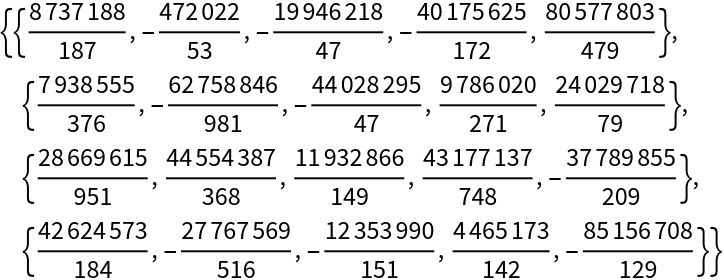Wolfram Function Repository
Instant-use add-on functions for the Wolfram Language
Function Repository Resource:
Compute a reduced basis for a set of vectors, along with a unimodular matrix that converts from the vectors to the reduced basis
ResourceFunction["ExtendedLatticeReduce"][lat] computes a reduced basis ℬ for the lattice of integer vectors lat, returning the pair {𝒰,ℬ}, where 𝒰 is a unimodular conversion matrix satisfying 𝒰.lat=ℬ. |
Create an integer lattice comprised of two columns of large integers augmented on the right by an identity matrix:
| In[1]:= |
|
| Out[1]= |
|
Reduce the lattice:
| In[2]:= |
|
| Out[2]= |

|
Check the conversion matrix equation:
| In[3]:= |
|
| Out[3]= |
|
Check that the conversion matrix is unimodular:
| In[4]:= |
|
| Out[4]= |
|
Check that LatticeReduce gives the same reduced lattice (this is not strictly necessary):
| In[5]:= |
|
| Out[5]= |
|
Create a rational lattice:
| In[6]:= |
|
| Out[6]= |

|
Compute a reduction of the lattice along with the corresponding unimodular conversion matrix::
| In[7]:= |
|
| Out[7]= |

|
Reduce a lattice of Gaussian integers with larger entries in the leftmost two columns:
| In[8]:= |
![SeedRandom[1234];
c1 = 2;
c2 = 5;
lat = Join[
RandomInteger[{-10^8, 10^8}, {4, c1}] + I*RandomInteger[{-10^8, 10^8}, {4, c1}], RandomInteger[{-10^3, 10^3}, {4, c2}] + I*RandomInteger[{-10^3, 10^3}, {4, c2}], 2];
{umat, redlat} = ResourceFunction["ExtendedLatticeReduce"][lat]](https://www.wolframcloud.com/obj/resourcesystem/images/8a3/8a36cdcf-baa5-4769-af66-0c8877992651/1f1aad256e749167.png)
|
| Out[8]= |

|
Check the result:
| In[9]:= |
|
| Out[9]= |
|
Create a large matrix with big integers in the first two columns and an identity matrix on the right:

First compute the default reduction:
| In[10]:= |
|
| Out[10]= |
|
Check the conversion matrix criteria:
| In[11]:= |
|
| Out[11]= |
|
Computing a reduction of higher quality typically takes longer:
| In[12]:= |
|
| Out[12]= |
|
Using a smaller reduction size ratio setting typically gives a faster computation:
| In[13]:= |
|
| Out[13]= |
|
The higher quality reduction manifests by most rows in the “stronger” result having norms smaller than for corresponding rows in the default reduction:
| In[14]:= |
|
| Out[14]= |

|
The lower quality reduction manifests by most rows in the “weaker” result having norms larger than for corresponding rows in the default reduction:
| In[15]:= |
|
| Out[15]= |

|
This work is licensed under a Creative Commons Attribution 4.0 International License